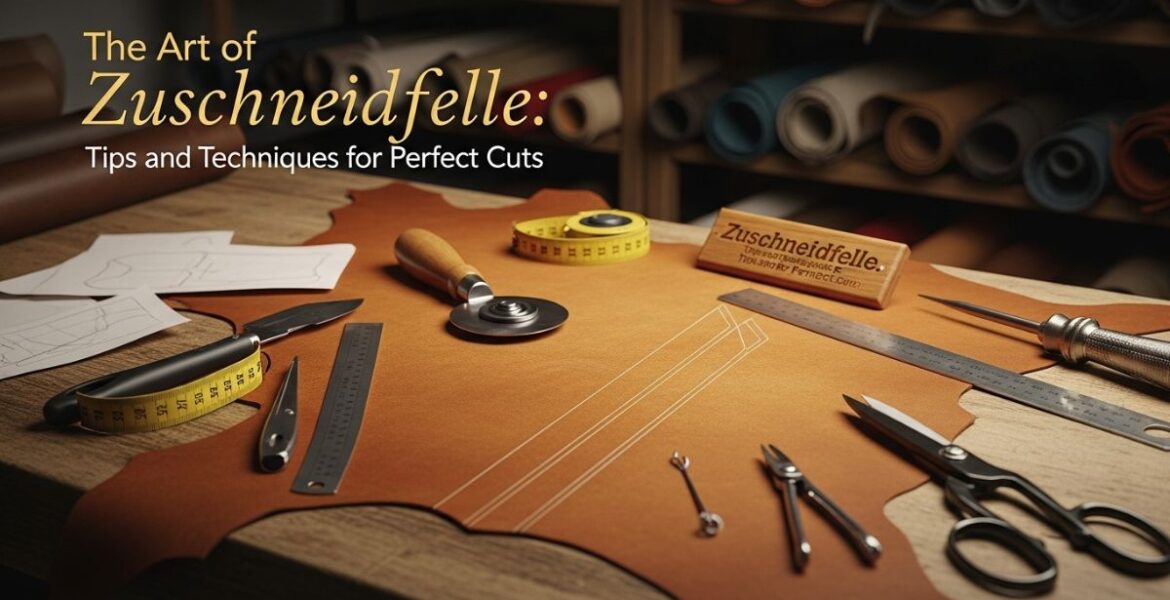The Art of zuschneidfelle: Tips and Techniques for Perfect Cuts

Zuschneidfelle is more than just a technical term; it’s an art form that has captivated leatherworkers for generations. Whether you’re crafting intricate bags, stylish belts, or unique pieces of furniture, mastering the technique of zuschneidfelle can elevate your work to new heights. The precision involved in cutting leather shapes not only affects the aesthetics of your project but also its durability and function.
If you’re curious about how to perfect those cuts and bring your leather projects to life, you’re in the right place! This guide will take you through everything you need to know about zuschneidfelle—from understanding what it is to avoiding common pitfalls that can frustrate even seasoned artisans. Get ready to dive into a world where skill meets creativity and precision reigns supreme.
What is Zuschneidfelle?
Zuschneidfelle refers to the specialized technique of cutting leather into precise shapes and sizes. This method is crucial for anyone looking to create high-quality leather goods, as it lays the foundation for every project.
The term itself combines German words that relate to cutting and skins, emphasizing its focus on transforming raw material into functional pieces. Mastery of zuschneidfelle ensures that each cut is clean and accurate, which significantly impacts the final product’s appearance and durability.
Craftspeople often use this technique in various applications—ranging from fashion accessories to upholstery. The artistry involved requires an understanding of both the properties of different leathers and the tools best suited for achieving optimal results. With practice, one can turn a simple piece of hide into a stunning work of craftsmanship through skillful zuschneidfelle techniques.
The History and Significance of Zuschneidfelle
Zuschneidfelle, or cutting hides, have a rich history rooted in ancient craftsmanship. These materials were essential for various trades and crafts across cultures. Historically, artisans relied on zuschneidfelle to create everything from clothing to protective gear.
The technique itself evolved over centuries as leatherworking advanced. Each region developed its unique methods based on available resources and cultural practices. This adaptability highlights the significance of zuschneidfelle not just as a tool but as an art form.
In many societies, working with leather was more than a trade; it symbolized skill and tradition passed down through generations. The precision required in making clean cuts reflects the dedication of craftsmen who transformed raw materials into valuable creations.
Today, zuschneidfelle still holds importance among leatherworkers, reminding us of our connection to the past while fostering innovation in modern design techniques.
Essential Tools for Zuschneidfelle
When diving into the world of zuschneidfelle, having the right tools is crucial for achieving precision. A sharp rotary cutter or a utility knife tops the list. These allow for clean lines and effortless cutting through various leather thicknesses.
Equally important are self-healing cutting mats. They protect your workspace while extending the life of your blades. Investing in one can save you from a lot of frustration down the line.
Next up is a reliable ruler or straightedge. This tool helps guide your cuts, ensuring accuracy every time. Consider using an acrylic ruler with grid markings for added convenience.
Don’t forget about crafting scissors designed specifically for leatherwork. Their unique shape makes them perfect for tight curves and intricate designs.
Good quality adhesive will keep your pieces securely together during assembly, allowing you to focus on that flawless finish without worrying about shifting materials.
Techniques for Accurate and Clean Cuts
Achieving accurate and clean cuts when working with zuschneidfelle is crucial for any leather project. Start by ensuring your workspace is organized. A clutter-free environment allows for better focus.
Utilize a sharp craft knife or rotary cutter for precision. Dull blades can lead to uneven edges and frayed pieces, which can ruin the overall look of your work.
Measure twice before cutting. Use a ruler or straightedge to draw clear guidelines on the leather. This step minimizes errors and helps maintain symmetry.
Consider using weights or clamps to hold down your material while cutting. This prevents slipping, ensuring that every slice stays true to your intended line.
Practice makes perfect; don’t hesitate to experiment on scrap pieces first. Each cut will enhance your skill level, leading you closer to professional results in no time.
Tips for Working with Different Types of Leather
Each type of leather has unique characteristics that influence how you work with it. For instance, full-grain leather is sturdy but can be challenging to cut. Use a sharp blade and take your time for precision.
Nappa leather, on the other hand, is soft and luxurious. It’s more forgiving when cutting but requires careful handling to avoid stretching or tearing. A rotary cutter can make clean lines here.
Suede offers a textured finish but tends to fray easily. Always use specialized scissors designed for fabric to achieve smooth edges without damage.
When working with exotic leathers like snake or crocodile, patience is key due to their irregular surfaces. Mark your cuts lightly and proceed slowly.
Remember that all types benefit from proper conditioning before cutting or stitching. A little preparation goes a long way in achieving stunning results!
Common Mistakes to Avoid in Zuschneidfelle
When diving into the world of zuschneidfelle, beginners often stumble over a few common pitfalls. One major mistake is not preparing the leather properly before cutting. Skipping this step can lead to uneven edges and a frustrating experience.
Another frequent error involves using dull tools. Sharp blades are paramount for clean cuts; otherwise, you risk fraying the material or making jagged lines that compromise your project’s integrity.
Rushing through measurements can be detrimental too. Taking your time ensures precision and prevents costly mistakes later on.
It’s also crucial to avoid cutting against the grain of the leather. This can affect both aesthetics and durability.
Neglecting safety precautions while working with sharp instruments poses unnecessary risks. Always prioritize safety to enjoy your crafting journey fully without mishaps along the way!
Conclusion:
The art of zuschneidfelle is a fascinating blend of skill, precision, and creativity. Understanding its history adds depth to the craft, linking modern techniques with traditions that have stood the test of time.
Having the right tools makes a significant difference in achieving clean cuts. Investing in quality knives, cutting mats, and rulers can elevate your work from amateur to professional level. Mastering various cutting techniques ensures consistency and accuracy—a must for any serious leatherworker.
You may also like

Leave a Reply